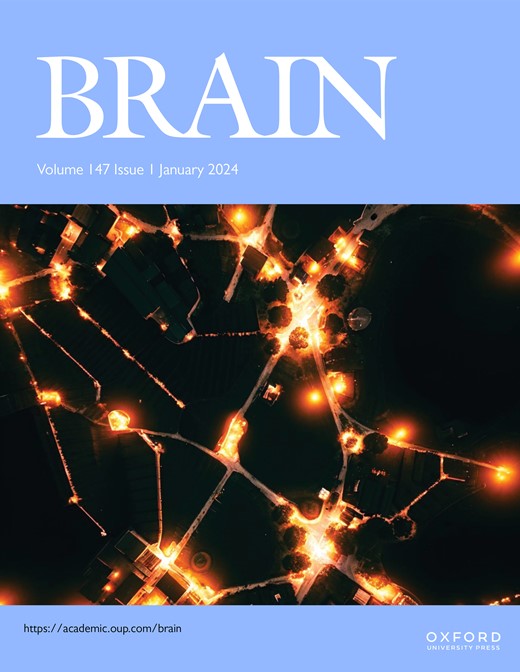CACNA1A 单倍性缺失会导致突触功能降低和内在兴奋性增加
IF 10.6
1区 医学
Q1 CLINICAL NEUROLOGY
引用次数: 0
摘要
编码 P/Q 型电压门控钙通道孔形成 α1 亚基的 CACNA1A 基因的单倍体缺陷与小脑共济失调、伴有癫痫和智力障碍的神经发育综合征等多种临床表型有关。为了了解 CACNA1A 功能缺失变体的病理机制,我们通过将同源诱导多能干细胞系分化成谷氨酸能神经元,建立了 CACNA1A 单倍体缺失的人类神经元模型,并通过电生理学、基因表达分析和硅建模相结合的方法研究了 CACNA1A 单倍体缺失对成熟神经元网络的影响。我们观察到 CACNA1A+/- 网络中的网络同步性发生了改变,同时出现了突触缺陷,尤其是缺乏 GluA2 的 AMPA 受体的贡献增加。耐人寻味的是,这些突触扰动与非突触驱动活动的增加并存,其特征是微电极阵列上的 NMDA 和 AMPA 受体受到抑制。单细胞电生理学和基因表达分析通过钾通道功能和表达的降低证实了内在兴奋性的增加。此外,我们还观察到 4-aminopyridine 能部分缓解 CACNA1A+/- 网络表型,4-aminopyridine 是对发作性共济失调 2 型的一种治疗干预。正向调节 KCa2 通道可逆转 CACNA1A+/- 网络电生理表型。总之,我们的研究开创性地描述了CACNA1A单倍体缺陷的人类诱导多能干细胞衍生神经元模型,并揭示了新的机理。除了突触缺陷外,该神经元模型还表现出由钾通道功能减弱介导的固有兴奋性增加,突出了其作为具有预测效力的治疗发现平台的潜力。本文章由计算机程序翻译,如有差异,请以英文原文为准。
CACNA1A haploinsufficiency leads to reduced synaptic function and increased intrinsic excitability
Haploinsufficiency of the CACNA1A gene, encoding the pore-forming α1 subunit of P/Q-type voltage-gated calcium channels, is associated with a clinically variable phenotype ranging from cerebellar ataxia, to neurodevelopmental syndromes with epilepsy and intellectual disability. To understand the pathological mechanisms of CACNA1A loss-of-function variants, we characterized a human neuronal model for CACNA1A haploinsufficiency, by differentiating isogenic induced pluripotent stem cell lines into glutamatergic neurons, and investigated the effect of CACNA1A haploinsufficiency on mature neuronal networks through a combination of electrophysiology, gene expression analysis, and in silico modeling. We observed an altered network synchronization in CACNA1A+/- networks alongside synaptic deficits, notably marked by an augmented contribution of GluA2-lacking AMPA receptors. Intriguingly, these synaptic perturbations coexisted with increased non-synaptically driven activity, as characterized by inhibition of NMDA and AMPA receptors on micro-electrode arrays. Single-cell electrophysiology and gene expression analysis corroborated this increased intrinsic excitability through reduced potassium channel function and expression. Moreover, we observed partial mitigation of the CACNA1A+/- network phenotype by 4-aminopyridine, a therapeutic intervention for episodic ataxia type 2. Positive modulation of KCa2 channels could reverse the CACNA1A+/- network electrophysiological phenotype. In summary, our study pioneers the characterization of a human induced pluripotent stem cell-derived neuronal model for CACNA1A haploinsufficiency, and has unveiled novel mechanistic insights. Beyond showcasing synaptic deficits, this neuronal model exhibited increased intrinsic excitability mediated by diminished potassium channel function, underscoring its potential as a therapeutic discovery platform with predictive validity.
求助全文
通过发布文献求助,成功后即可免费获取论文全文。
去求助
来源期刊

Brain
医学-临床神经学
CiteScore
20.30
自引率
4.10%
发文量
458
审稿时长
3-6 weeks
期刊介绍:
Brain, a journal focused on clinical neurology and translational neuroscience, has been publishing landmark papers since 1878. The journal aims to expand its scope by including studies that shed light on disease mechanisms and conducting innovative clinical trials for brain disorders. With a wide range of topics covered, the Editorial Board represents the international readership and diverse coverage of the journal. Accepted articles are promptly posted online, typically within a few weeks of acceptance. As of 2022, Brain holds an impressive impact factor of 14.5, according to the Journal Citation Reports.
 求助内容:
求助内容: 应助结果提醒方式:
应助结果提醒方式:


